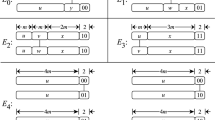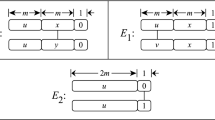Abstract
Exchanged hypercubes (Loh et al. in IEEE Trans Parallel Distrib Syst 16:866–874, 2005) are spanning subgraphs of hypercubes with about one half of their edges but still with many desirable properties of hypercubes. In this paper, it is shown that distance properties of exchanged hypercubes are also comparable to the corresponding properties of hypercubes. The average distance and the surface area of exchanged hypercubes are computed and it is shown that exchanged hypercubes have asymptotically the same average distance as hypercubes. Several additional metric and other properties are also deduced and it is proved that exchanged hypercubes are prime with respect to the Cartesian product of graphs.

Similar content being viewed by others
References
Angjeli A, Cheng E, Lipták L (2013) Linearly many faults in dual-cube-like networks. Theor Comput Sci 472:1–8
Braun H, Stephan FC (1993) On optimizing diameter and average distance of directed interconnected networks. IEEE Trans Comput 42:353–358
Chen J-C, Tsai C-H (2011) Conditional edge-fault-tolerant Hamiltonicity of dual-cubes. Inform Sci 181:620–627
Cheng E, Qiu K, Shen Z (2014) The edge-centered surface area of the arrangement graph. J Comb Optim 27:49–64
Chen YW (2007) A comment on “The exchanged hypercube”. IEEE Trans Parallel Distrib Syst 18:576
Cheng B, Fan J, Jia X, Jia J (2013) Parallel construction of independent spanning trees and an application in diagnosis on Möbius cubes. J Supercomput 65:1279–1301
Cheng E, Qiu K, Shen Z (2011) On the surface areas and average distances of meshes and tori. Parallel Process Lett 21:61–75
Cheng E, Qiu K, Shen Z (2012) On the surface area of the augmented cubes. J Supercomput 61:856–868
Dinneen MJ, Hafner PR (1994) New results for the degree/diameter problem. Networks 24:359–367
Dobrynin AA, Entringer R, Gutman I (2001) Wiener index of trees: theory and applications. Acta Appl Math 66:211–249
Dobrynin AA, Gutman I, Klavžar S, Žigert P (2002) Wiener index of hexagonal systems. Acta Appl Math 247–294
Du Z, Ilić A (2013) On AGX conjectures regarding average eccentricity. MATCH Commun Math Comput Chem 69:597–609
Fink J (2007) Perfect matchings extend to Hamilton cycles in hypercubes. J Combin Theory Ser B 97:1074–1076
Graham N, Harary F (1988) The number of perfect matchings in a hypercube. Appl Math Lett 1:45–48
Gutman I, Cruz R, Rada J (2014) Wiener index of Eulerian graphs. Discrete Appl Math 162:247–250
Hammack R, Imrich W, Klavžar S (2011) Handbook of product graphs, 2nd edn. CRC Press, Boca Raton
Hinz AM, Parisse D (2012) The average eccentricity of Sierpiński graphs. Graphs Combin 28:671–686
Imani N, Sarbazi-Azad H, Akl SG (2009) Some topological properties of star graphs: the surface area and volume. Discret Math 309:560–569
Imrich W, Klavžar S, Rall DF (2008) Topics in graph theory: graphs and their Cartesian products. A K Peters, Wellesley
Kim J-S, Kim SW, Cheng E, Lipták L (2012) Topological properties of folded hyper-star networks. J Supercomput 59:1336–1347
Klavžar S (2013) Structure of Fibonacci cubes: a survey. J Comb Optim 25:505–522
Klavžar S, Ma M (2014) The domination number of exchanged hypercubes. Inf Process Lett 114:159–162
Klavžar S, Nadjafi-Arani MJ (2013) Wiener index versus Szeged index in networks. Discret Appl Math 161:1150–1153
Kuo C-N, Chou H-H, Chang N-W, Hsieh S-Y (2013) Fault-tolerant path embedding in folded hypercubes with both node and edge faults. Theor Comput Sci 475:82–91
Li X-J, Xu J-M (2013) Generalized measures of fault tolerance in exchanged hypercubes. Inf Process Lett 113:533–537
Li Y, Peng S (2000) Dual-cubes: a new interconnection network for high-performance computer clusters. In: Proceedings of the 2000 international computer architecture, pp 51–57
Li Y, Peng S, Chu W (2004) Efficient collective communications in dual-cube. J Supercomput 28:71–90
Loh PKK, Hsu WJ, Pan Y (2005) The exchanged hypercube. IEEE Trans Parallel Distrib Syst 16:866–874
Ma M, Liu B (2009) Cycles embedding in exchanged hypercubes. Inf Process Lett 110:71–76
Ma M (2010) The connectivity of exchanged hypercubes. Discret Math Algorithms Appl 2:213–220
Ma M, Zhu L (2011) The super connectivity of exchanged hypercubes. Inf Process Lett 111:360–364
Mukwembi S (2013) Average distance, independence number, and spanning trees. J Graph Theory. doi:10.1002/jgt.21758
Pesek I, Rotovnik M, Vukičević D, Žerovnik J (2010) Wiener number of directed graphs and its relation to the oriented network design problem. MATCH Commun Math Comput Chem 64:727–742
Shen Z, Qiu K, Cheng E (2009) On the surface area of the \((n, k)\)-star graph. Theor Comput Sci 410:5481–5490
Tsai T-H, Chen YC, Tan JJM. Internally disjoint paths in a variant of the hypercube. In: Chang R-S, Jain LC, Peng SL (eds) Advances in intelligent systems and applications, vol 1, SIST 20. Springer, Berlin, pp 89–96
Wang S, Zhang G, Feng K (2012) Fault tolerance in \(k\)-ary \(n\)-cube networks. Theor Comput Sci 460: 34–41
Wang X, Fan J, Jia X, Zhang S, Yu J (2011) Embedding meshes into twisted-cubes. Inf Sci 181:3085–3099
Acknowledgments
We would like to thank the anonymous referees for their helpful comments and suggestions. This work was supported in part by ARRS Slovenia under the grant P1-0297, the China-Slovenia bilateral grant BI-CN/11-13-001, and the national natural science foundation of China 11101378.
Author information
Authors and Affiliations
Corresponding author
Rights and permissions
About this article
Cite this article
Klavžar, S., Ma, M. Average distance, surface area, and other structural properties of exchanged hypercubes. J Supercomput 69, 306–317 (2014). https://doi.org/10.1007/s11227-014-1153-6
Published:
Issue Date:
DOI: https://doi.org/10.1007/s11227-014-1153-6




